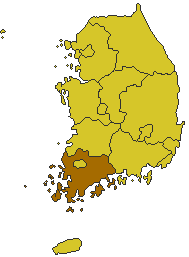This article needs additional citations for verification .(May 2021) |
You can help expand this article with text translated from the corresponding article in Korean. (May 2021)Click [show] for important translation instructions.
|
| Yeosu–Suncheon rebellion | |||||||
|---|---|---|---|---|---|---|---|
| Part of the division of Korea | |||||||
 Map of South Korea with South Jeolla highlighted | |||||||
| |||||||
| Belligerents | |||||||
Local supporters 14th regiment | |||||||
| Commanders and leaders | |||||||
| Strength | |||||||
| 2,000–3,000 | Unknown | ||||||
| Casualties and losses | |||||||
| 2,976–3,392 total dead, South Korea's Ministry of National Defense and Jeollanam-do Provincial Government source claim 12,000 total dead. [1] | |||||||
The Yeosu-Suncheon rebellion, also known as the Yeo-Sun incident (Yeo-Sun an abbreviation of Yeosu and Suncheon), was a rebellion that began in October 1948 and mostly ended by November of the same year. However, pockets of resistance lasted through to 1957, almost 10 years later.
Contents
- Background and lead-up
- Political situation in Korea
- Suppression of the Jeju Uprising
- Rebellion
- October
- November – containment and suppression
- The United States Involvement
- After the rebellion: fatalities and impact of the incident
- See also
- References
It is often called a "rebellion incident", but it is used as a case of "Yeosu and Suncheon incident" or "Yeosu, Suncheon 10.19 incident" since 1995 because the residents of the area may have mistaken it as the main object of the uprising. [2]
The rebellion took place in the cities of Yeosu and Suncheon and various surrounding towns in the South Jeolla province of South Korea. Rising anti-government sentiment towards the Syngman Rhee regime ignited in rebellion as 2,000 left-leaning soldiers based in the Yeo-Sun area raised arms in opposition to the Rhee government's handling of the Jeju Uprising, which had occurred just months earlier in April.
Park Chung-hee, who would later become a President of South Korea during military dictatorship era, participated in the rebellion, although he was allegedly given leniency in exchange for aiding in the hunt for others involved in the rebellion. [3]
